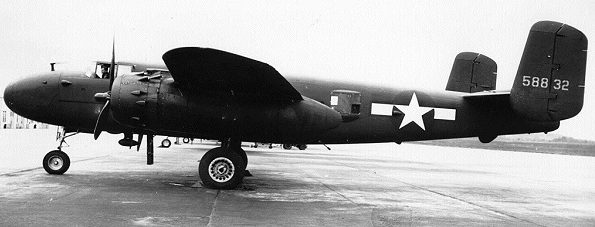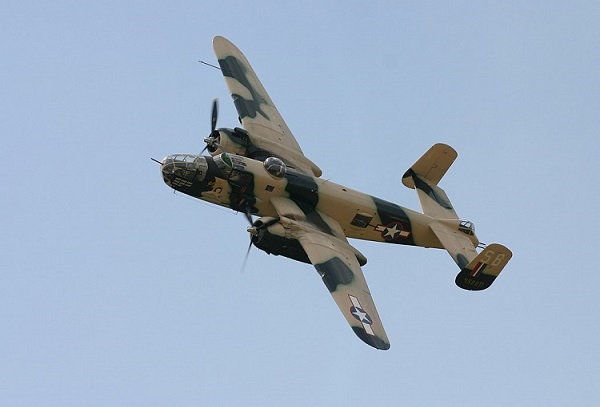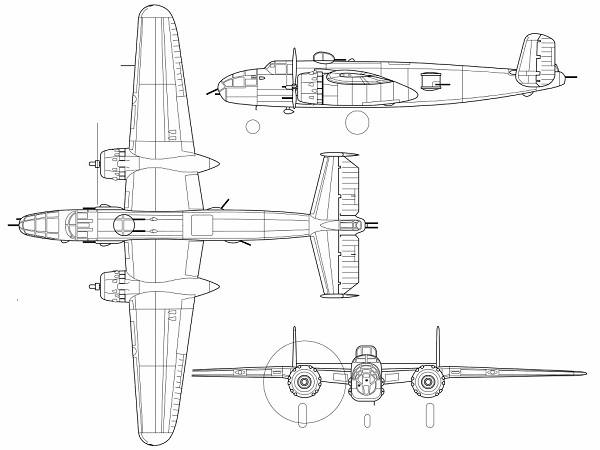

The North American B-25 Mitchell is an airplane introduced in 1941 and named in honor of Major General William "Billy" Mitchell, a pioneer of U.S. military aviation.[2] Used by many Allied air forces, the B-25 served in every theater of World War II and, after the war ended, many remained in service, operating across four decades. Produced in numerous variants, nearly 10,000 B-25s were built. These included a few limited models such as the F-10 reconnaissance aircraft and the AT-24 crew trainers;and the United States Marine Corps' PBJ-1 patrol bomber.

The Royal Canadian Air Force (RCAF) used the B-25 Mitchell for training during the war. Post-war use saw continued operations with most of 162 Mitchells received. The first B-25s had originally been diverted to Canada from RAF orders. These included one Mitchell I, 42 Mitchell IIs, and 19 Mitchell IIIs. No 13 (P) Squadron was formed unofficially at RCAF Rockcliffe in May 1944 and used Mitchell IIs on high-altitude aerial photography sorties. No. 5 OTU (Operational Training Unit) at Boundary Bay, British Columbia and Abbotsford, British Columbia, operated the B-25D Mitchell in the training role together with B-24 Liberators for Heavy Conversion as part of the BCATP. The RCAF retained the Mitchell until October 1963.[26]
No 418 (Auxiliary) Squadron received its first Mitchell IIs in January 1947. It was followed by No 406 (auxiliary), which flew Mitchell IIs and IIIs from April 1947 to June 1958. No 418 Operated a mix of IIs and IIIs until March 1958. No 12 Squadron of Air Transport Command also flew Mitchell IIIs along with other types from September 1956 to November 1960. In 1951, the RCAF received an additional 75 B-25Js from USAF stocks to make up for attrition and to equip various second-line units.
Crew: 5 (one pilot, navigator/bombardier, turret gunner/engineer, radio operator/waist gunner, tail gunner)
Length: 52 ft 11 in (16.13 m)
Wingspan: 67 ft 7 in (20.60 m)
Height: 16 ft 4 in (4.98 m)
Wing area: 618 sq ft (57.4 m2)
Airfoil: root: NACA 23017; tip: NACA 4409R[47]
Empty weight: 19,480 lb (8,836 kg)
Max takeoff weight: 35,000 lb (15,876 kg)
Powerplant: 2 × Wright R-2600-92 Twin Cyclone 14-cylinder two-row air-cooled radial piston engines, 1,700 hp (1,300 kW) each
Maximum speed: 272 mph (438 km/h; 236 kn) at 13,000 ft (4,000 m)
Cruise speed: 230 mph (370 km/h; 200 kn)
Range: 1,350 mi (1,173 nmi; 2,173 km)
Service ceiling: 24,200 ft (7,400 m)
Guns: 12–18 × .50 in (12.7 mm) machine guns and 75 mm (2.95 in) T13E1 cannon
Hardpoints: 2,000 lb (900 kg) ventral shackles to hold one external Mark 13 torpedo[48]
Rockets: racks for eight 5 in (127 mm) high velocity aircraft rockets (HVAR)
Bombs: 3,000 lb (1,360 kg) bombs



